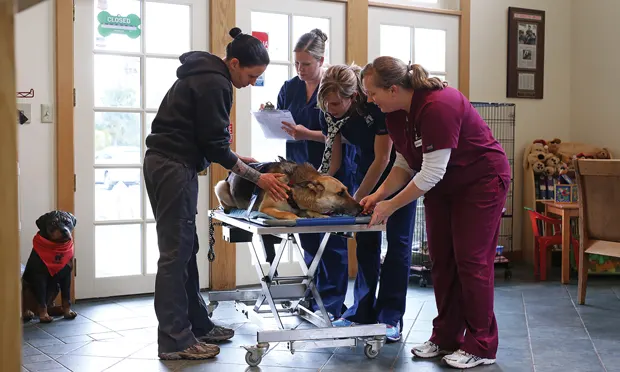The Art of Triage

The word “triage” is derived from the French word “trier,” meaning “to sort.” Whether working in an emergency or general practice, veterinary technicians are called upon daily to utilize their triage skills. Proficiency in emergency assessment and strong communication skills are essential for providing quality care.
Merriam Webster’s definition of triage is “the sorting of and allocation of treatment to patients … according to a system of priorities designed to maximize the number of survivors.”
The triage system is designed to ensure that the most critically ill patients are seen first. To maximize efficiency, the veterinary team must work together to ensure the most successful outcome.
Related Article: The Art of Telephone Triage
The triage team consists of the client, receptionist, veterinary technician, veterinary assistant, and veterinarian. Each individual has an important role in identifying and communicating concerns.
Client: Recognizes the need for emergency treatment and contacts the practice
Receptionist: Often the first person to come in contact with the client via phone or the front desk. Identifies the client’s urgency and alerts the veterinary team
Veterinary technician: Communicates with the client and evaluates the patient. With the veterinary assistant, assists the veterinarian in diagnostic interventions and carrying out a treatment plan.
Phone Triage
Because clients often contact the practice after an emergency occurs and before presentation, the triage team should always be prepared to perform a “phone triage.” This allows the team to identify certain factors to facilitate preparation for the emergent patient’s arrival.
Initially, a receptionist or veterinary technician should determine whether the emergency is related to a medical condition or a traumatic event. After acknowledging the client’s chief complaint and the patient’s signalment, the veterinary technician should inquire about the illness duration or time of the event; ask about the patient’s breathing status, mucous membrane color, mentation, and ambulatory status to determine the sense of urgency and prepare for the emergency presentation; and ascertain the estimated time of arrival.
Related Article: Triaging Traumatic Brain Injuries
Physical Assessment
Upon the patient’s arrival, the veterinary technician should perform an initial assessment, beginning with a “survey of the scene.”1 A quick observation is helpful to gain valuable information about the patient’s overall condition. Visual assessment of the patient should include attention to mentation, posture and position, any bleeding/obvious wounds, or signs of distress. Also, obtain a brief history from the client to identify the reason for the emergency presentation.
The first step in the primary physical assessment is evaluating the patient’s ABCs (Airway, Breathing, and Circulation).1 The airway is then evaluated for patency or obstruction and the patient’s breathing status assessed to determine whether the patient is breathing and doing so appropriately.1 It is important to note the patient’s position and any increase in respiratory effort. The patient’s chest should be auscultated for the presence or absence of breath sounds. The circulatory system should be evaluated through cardiac auscultation, palpation of the peripheral pulses, and examination of the mucous membranes.1
Take note of any current medications and previous medical conditions that may affect the emergency situation.
Impediments of any of the ABCs should be corrected through any necessary immediate lifesaving interventions. Upon recognizing the need for emergency treatment, obtain client consent, if possible, to treat the patient or perform lifesaving procedures if necessary. Obtaining consent enables the veterinarian to rapidly develop a treatment plan of therapeutic interventions that may help save the patient’s life.
It is also in the best interest of the client and the practice to provide a standard estimate that covers initial stabilization of the patient. Conditions that require immediate therapeutic interventions include trauma, respiratory, cardiac, and neuromuscular emergencies, shock, and cardiopulmonary arrest.2
The triage system is also intended to ensure that the patient’s most life-threatening conditions are treated first. You may need to filter through the medical history from the client to identify the most critical ailment. Asking open-ended questions in a private and nonjudgmental atmosphere is helpful for gathering the most accurate details. It is important to take note of any current medications and previous medical conditions that may affect the emergency situation. The patient’s vaccination status and information about environmental exposure via boarding facilities or travel is an important component of a complete medical history.
After the initial assessment, communicate any immediate concerns to the veterinarian, who should perform a more comprehensive evaluation and create a treatment plan.
Conclusion
The main goal in the triage process is to recognize and treat the most life-threatening emergencies. As a veterinary technician, you must be able to sort through various problems and identify which conditions require immediate attention and treatment. Appropriate preparation and good communication are essential to ensure a positive outcome for emergent patients.